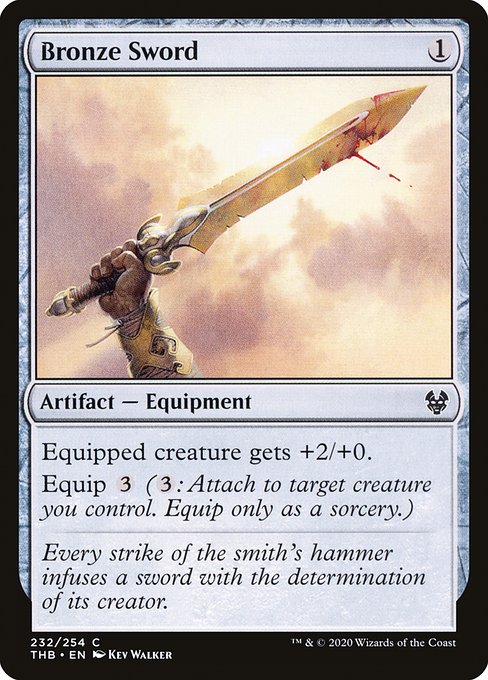
Image courtesy of Scryfall.com
Bronze Sword: Mastering Creative MTG Equipment Plays
In the grand tradition of undercosted threats and clever tempo plays, Bronze Sword stands out as a tiny beacon for players who love to innovate with the equipment strategy. This colorless artifact from Theros Beyond Death costs only {1} to cast, which feels like a wink to power creep and a nod to the old days when you could set a plan in motion with a single card. Its stat line is simple but brutally effective: an equipped creature gains +2/+0. The real head-scratcher and source of creative joy comes from the equip ability: Equip {3} — attach to a creature you control, with the caveat that you can only do so as a sorcery. That constraint isn’t a roadblock; it’s a design prompt, inviting you to choreograph your turns like a smith hammering out the perfect blade. 🧙♂️🔥
Flavor text for Bronze Sword anchors the narrative: “Every strike of the smith's hammer infuses a sword with the determination of its creator.” The line isn’t just lore fluff; it’s a reminder that creative play often comes from intentional moment-to-moment decisions. The hammer’s rhythm translates into game rhythm: you choose when to commit to the blade, when to pass the turn, and when to risk a pivotal exchange. In a world of double-faced cards, sweepers, and planeswalkers, Bronze Sword is a humble reminder that steady, precise upgrades can tilt the battlefield just enough to push through a win. 🎨⚔️
Designing for Creativity: What Bronze Sword Teaches Us
From a design perspective, Bronze Sword embodies time-honored MTG principles: low mana, repeatable effect, and an equip cost that scales the strategic payoff. Its colorless nature makes it a chameleon in virtually any color identity, a feature that invites creative deck construction rather than forcing you into a single archetype. The +2/+0 buff is modest, but in the right shell — be it a wide offensive plan, a mono-color aggro, or an aristocrats-style board state — that extra two points can be the difference between a trade and a smackdown. The sorcery-speed equip limitation is a masterstroke: it prevents abuse of instant-speed shenanigans and steadies the tempo, encouraging players to build for the long game rather than a flash-in-the-pan burst. 🧙♂️🔥
Creativity in equipment often comes from limitation. Bronze Sword asks, “What small, steady upgrade do I keep applying to my best creature?” The answer, almost always, is a combo of patience and combat math.
Strategically, Bronze Sword shines in environments that reward a single, resilient threat becoming a platform for multiple threats. A creature with +2 power gives you a predictable damage path, enabling you to pressure an opponent while keeping mana open for other finishes. In a world where one big planeswalker can swing the fate of a game, Bronze Sword is the kind of tool that helps you control the tempo of the match. It’s not the flashiest card in your stack, but it’s the kind that makes it into the “how did I win this game?” category of memory. And in multiplayer or commander formats, that stable, reliable booster can snowball into a victorious board state when paired with a resilient creature and smart removal timing. 🧠🎲
Creative play with artifacts like Bronze Sword also invites you to consider the ecosystem around equipment. Cards such as tutors, blink effects, or recursion can maximize the value of a small, efficient +2 attack boost. You might find yourself stacking cheap equipment with multiple copies traveling through a deck via effects that return or reattach equipment, turning a modest investment into a sustained threat. The Theros Beyond Death-era flavor of heroism and craftsmanship feeds into that narrative: the sword is not a one-shot gadget but a testament to the maker’s will, echoing in every combat step you take. ⚔️💎
Practical Play Examples: How to Use Bronze Sword Creatively
Scenario one: you’re deploying a lean, creature-forward deck that wants to push through for lethal damage. Bronze Sword slides onto your best attacker, turning a 2/2 into a 4/2 and enabling you to threaten multiple angles. You might pair it with a pump spell or a follow-up creature that adds pressure, turning a single creature into a credible alpha strike. Scenario two: you’re in a stalemate and need a reliable way to convert incremental damage into a win. The Sword’s modest buff creates a dependable clock that keeps you in the game while you set up a longer-term plan. In either case, the key is timing the equip phase to line up with your next attack, keeping mana available for defense or a surprise answer to your opponent’s board. 🧙♂️🔥
Don’t overlook art and presentation either. The artwork by Kev Walker and the clean, functional silhouette of Bronze Sword evoke a blacksmith’s workshop and a quiet, focused craft. It’s a card that tells players: you don’t need a flashy result to make a big impact—steadiness, reliability, and precise execution can win games and inspire new ways to think about equipment in the broader MTG landscape. The piece sits comfortably in a collector’s binder as well, a nice foil to cards with more dramatic rarities, while still offering solid value in foil and nonfoil forms. 🧨🎨
For fans who love the cross-pollination of games and design, Bronze Sword also serves as a perfect talking point about equipment’s role in creative play. It’s a reminder that the thrill of Magic isn’t just in the big plays; it’s in recognizing a small advantage and weaving it into a larger yarn of strategy, lore, and community storytelling. And if you’re exploring cross-promotional gear and accessories, a well-placed analogue—like a sturdy, well-made accessory—can mirror that patient, durable mindset. Speaking of accessories, the featured product below offers a practical, stylish counterpoint to desk setup and playspaces while you map out your next tournament-ready build. 🧙♂️🎲
Clear Silicone Phone Case – Slim, Durable, Open Port Design
More from our network
- https://blog.digital-vault.xyz/blog/post/how-demon-of-dark-schemes-shapes-fan-card-design/
- https://transparent-paper.shop/blog/post/monetize-your-icons-selling-vector-packs-online/
- https://crypto-acolytes.xyz/blog/post/inside-rust-how-community-workshop-creators-build-player-generated-content/
- https://blog.digital-vault.xyz/blog/post/un-cards-and-design-theory-sarkhan-dragonsoul/
- https://crypto-acolytes.xyz/blog/post/web3-gaming-guilds-building-communities-and-play-to-earn-economies/